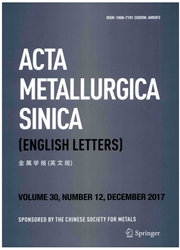

 中文摘要:
中文摘要:
Since most typical alloys in industrial applications are multicomponent with three or more components, and various CA models proposed in the past mainly focus on the binary alloys, a two-dimensional modified cellular automaton model allowing for the quantitatively predicting dendrite growth of multicomponent alloys in the low Pe′clet number regime is presented. The elimination of the mesh-induced anisotropy is achieved by adopting a modified virtual front tracking method. A new efficient method based on the lever rule is applied to calculate the solid fraction increment of the interfacial cells. The thermodynamic data such as liquidus temperature, the partition coefficients, and the slope of liquidus surface, needed for determining the dynamics of dendrite growth, are obtained by coupling with Pan Engine. This model is applied to simulate the dendrite morphology and microsegregation of Al–Cu–Mg ternary alloy both for single and multidendrites growth. The simulated results demonstrate that the difference of the concentration distribution profiles ahead of the dendrite tip for each alloying element mainly results from the different partition coefficients and solute diffusion coefficients. Comparison with the prediction of analytical model is carried out and it reveals the correctness of the model.Consequently, the difference in interdendritic microsegregation behavior of different components is analyzed.
 英文摘要:
英文摘要:
Since most typical alloys in industrial applications are multicomponent with three or more components, and various CA models proposed in the past mainly focus on the binary alloys, a two-dimensional modified cellular automaton model allowing for the quantitatively predicting dendrite growth of multicomponent alloys in the low P6clet number regime is presented. The elimination of the mesh-induced anisotropy is achieved by adopting a modified virtual front tracking method. A new efficient method based on the lever rule is applied to calculate the solid fraction increment of the interfacial cells. The thermodynamic data such as liquidus temperature, the partition coefficients, and the slope of liquidus surface, needed for determining the dynamics of dendrite growth, are obtained by coupling with PanEngine. This model is applied to simulate the dendrite morphology and microsegregation of A1-Cu-Mg temary alloy both for single and multi- dendrites growth. The simulated results demonstrate that the difference of the concentration distribution profiles ahead of the dendrite tip for each alloying element mainly results from the different partition coefficients and solute diffusion coefficients. Comparison with the prediction of analytical model is carded out and it reveals the correctness of the model. Consequently, the difference in interdendritic microsegregation behavior of different components is analyzed.
 同期刊论文项目
同期刊论文项目
 同项目期刊论文
同项目期刊论文
 A Modified Cellular Automaton Model for the Quantitative Prediction of Equiaxed and Columnar Dendrit
A Modified Cellular Automaton Model for the Quantitative Prediction of Equiaxed and Columnar Dendrit Progress on modeling and simulation of directional solidification of superalloy turbine blade castin
Progress on modeling and simulation of directional solidification of superalloy turbine blade castin Numerical Simulation of 3-D Dendritic Growth under Forced Convection Using the Modified Cellular Aut
Numerical Simulation of 3-D Dendritic Growth under Forced Convection Using the Modified Cellular Aut Numerical Simulation and Optimization of Directional Solidification Process of Single Crystal Supera
Numerical Simulation and Optimization of Directional Solidification Process of Single Crystal Supera Multiscale modelling and simulation of single crystal superalloy turbine blade casting during direct
Multiscale modelling and simulation of single crystal superalloy turbine blade casting during direct Simulation and experiments on plasticity and recrystallisation in SX superalloys by investment casti
Simulation and experiments on plasticity and recrystallisation in SX superalloys by investment casti Deformation and recrystallization of single crystal nickel-based superalloys during investment casti
Deformation and recrystallization of single crystal nickel-based superalloys during investment casti Simulationand Experimental study of Recrystallization Kinetics of Nickel Based SingleCrystal Superal
Simulationand Experimental study of Recrystallization Kinetics of Nickel Based SingleCrystal Superal Multiscale Modeling and Simulation of Directional Solidification Process of Turbine Blade Casting wi
Multiscale Modeling and Simulation of Directional Solidification Process of Turbine Blade Casting wi 期刊信息
期刊信息
